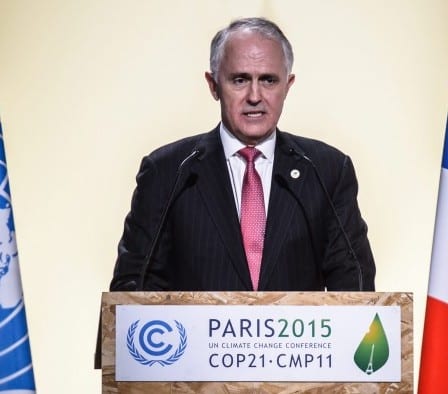“When Australia makes a commitment to a global agreement, we follow through and that is exactly what we are doing.” So said Malcolm Turnbull in comments to media after his government announced its plan to ratify the Paris Agreement on climate change by the end of this year.

The decision to fully commit to this global goal – delivered, with the above comments, so soon after the result of the US election – could be seen as a tacit message to the new US President-elect, who has vowed to unbind America from its own Paris commitments.
But even without reading anything too heroic into the move – which was made well after most other signatories, and more than a month after the Paris deal actually came into force – it is a Welcome Spot Of Good News, both for the global climate effort and for the Australian renewables industry.
Deputy PM Julie Bishop (foreign affairs) and federal energy minister Josh Frydenberg – both of whom are about to jet to COP22 climate talks in Marrakech – said in a statement on Thursday that the Turnbull government had tabled the Paris Agreement on climate change and the Doha Amendment to the Kyoto Protocol for Parliamentary and public scrutiny, with the goal of ratifying the Agreement by the end of 2016.
Under the Paris Agreement, Australia must continue to set its own emission reduction targets in contribution to the international effort to hold the increase in the global average temperature to well below 2°C above pre-industrial levels.
The ministers described the historic Paris deal as “a turning point in the global transition to a lower emission future,” but more importantly, as being in Australia’s “national interest”.
While encouraging, these words do not change the fact that the Coalition’s major climate policies, and especially its RET, are not considered up to the job of meeting Australia’s global commitments according to the Paris deal, according to many of the nation’s best analysis on the subject.
Thursday’s media statement also said that the government’s “suite of policies” were working to reduce Australia’s emissions “without driving up electricity prices,” a mantra the Coalition has used to justify its low ambition on renewables and other climate measures since the Abbott era.
Turnbull, however, seems upbeat. ”We are on track to meet and indeed beat our 2020 targets,” he said in comments on Thursday.
“We will review our climate and energy policies next year to ensure that we meet, as we believe we will, our 2030 targets under the agreement.”
Others are not so sure. Greenpeace Australia Pacific said the ratification was an important first step for Australia, but it needed to “make a huge climate U-turn” to live up to its part of the deal.
Erwin Jackson, deputy chief executive of The Climate Institute, said the move sent an “important international signal” about commitment to the climate effort, as well as to Australia’s renewables industry and investment market.
“China’s not going to stop decarbonising, [billionaire] Elon Musk is not going to stop building his giga-battery factory,” Jackson said in a statement.
Just yesterday, Jackson was keen to remind a Senate hearing on the retirement of Australia’s coal-fired generation fleet, that the Paris agreement required signatories to significantly step up climate action every five years.
Meanwhile, he said, Australian policy debate continues to focus on 2030, “not allowing us to think long term.”
Jackson said the more ambitious renewable energy targets of some of Australia’s states were in line with leading global analysts’ modelling on what was required to meet 1.5°C.
“Renewables is the primary technology and least cost option to get there,” he said.
“Targets of around 50 per cent renewable energy by 2030 are in the right ballpark. But in terms of industry investment, it would be better if it was a national policy,” he said
Jackson also told the Senate Committe that it was The Climate Institute’s view – and that of various other noted economists and analysts – that all of Australia’s remaining coal power stations would need to be closed by the early 2030s to keep to Australia’s emissions reduction commitments, which meant retiring “one Hazelwood a year”.
“For that same emissions reduction goal, no matter the mechanisms, no matter what new technologies come in, coal needs to be gone by 2035 – at the latest,” he said.








